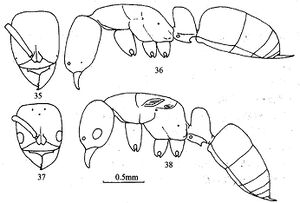Ponera paedericera
| Ponera paedericera | |
|---|---|
| Scientific classification | |
| Kingdom: | Animalia |
| Phylum: | Arthropoda |
| Class: | Insecta |
| Order: | Hymenoptera |
| Family: | Formicidae |
| Subfamily: | Ponerinae |
| Tribe: | Ponerini |
| Genus: | Ponera |
| Species: | P. paedericera |
| Binomial name | |
| Ponera paedericera Zhou, 2001 | |
The lone India record was collected in a winkler sample.
Identification
Zhou (2001) - Close to Ponera chiponensis, but differs from the latter in mandible basal 2/3 with a row of very indistinct denticles; anterior clypeal border without median tooth; terminal antennal segment stouter than that of the latter, 1.4 X as long as broad. Besides, the new species much larger in size than the latter.
Bharti and Rilta (2015) - The Chinese P. paedericera is now know to occur in India. This species is remarkably different from the other known Indian Ponera species by the following combination of characters: anterior margin of clypeus with a distinct blunt median tooth; antennal club with 3 segments; posterodorsal corners of propodeum rounded, declivity depressed, lateral sides of propodeum distinctly marginate; anterior face of petiole straight, dorsal and posterior faces form a single arched surface, anterodorsal corner blunt, dorsal surface smooth and shining, subpetiolar process with relatively large posteroventral teeth; head, mesosoma and the two basal segments of gaster densly and finely punctate; blackish in colour.
Keys including this Species
Distribution
Distribution based on Regional Taxon Lists
Oriental Region: India.
Palaearctic Region: China (type locality).
Distribution based on AntMaps
Distribution based on AntWeb specimens
Check data from AntWeb
Countries Occupied
| Number of countries occupied by this species based on AntWiki Regional Taxon Lists. In general, fewer countries occupied indicates a narrower range, while more countries indicates a more widespread species. |

|
Estimated Abundance
| Relative abundance based on number of AntMaps records per species (this species within the purple bar). Fewer records (to the left) indicates a less abundant/encountered species while more records (to the right) indicates more abundant/encountered species. |

|
Biology
|
Castes
Worker

| |
| . | |
Nomenclature
The following information is derived from Barry Bolton's Online Catalogue of the Ants of the World.
- paedericera. Ponera paedericera Zhou, 2001b: 38, 228, figs. 35-38 (w.q.) CHINA.
Unless otherwise noted the text for the remainder of this section is reported from the publication that includes the original description.
Description
Worker
Holotype: TL 3.3, HL 0.73, HW 0.56, CI 76, SL 0.53, SI 94, PW 0.47, AL 1.00, PH 0.50, PNL 0.28, DPW 0.43.
Paratypes: TL 3.1~3.3, HL 0.72~0.75, HW 0.55~0.60, CI 76~80, SL 0.51~0. 53, SI 86~94, PW 0.46~0.47, AL 0.96~1.02, PH 0.47~0.52, PNL 0.27~0.28, DPW 0.42~0.46.
Head subrectangular, longer than broad, as broad posteriorly as in front, with very feebly convex sides and straight to slightly concave occipital border. Mandible with 3 developed teeth, occupying approximately apical 1/3 of the length of masticatory margin, followed by a row of very indistinct denticles. Clypeus slightly convex, without median tooth. Eyes small, composed of a single ommatidium, situated in front of the midlength of the sides of head, about 4/5 the distance from lateral occipital border of head to the midpoint of anterior genal border. Antennae remarkably thick; scapes reaching occipital border; antennal club 5-segmented, ratio of length from base about 4 : 5 : 6 : 7 : 17, terminal segment about 1.4 X as long as broad.
Dorsal outline of alitrunk slightly convex in profile view; posterolateral corner of propodeum not pronounced, runing roundly into the declivity; declivitous face feebly concave. Mesopropodeal suture not incised on dorsum of alitrunk. Petiolar node thick, subrectangular in profile view, anterior face straight, posterior face convex, not forming angle with dorsal face; in dorsal view, anterior border semicircle and posterior border slightly concave. Fenestra of subpetiolar process subcircular, posterolateral tooth developed.
Head and antennal scapes densely punctate; punctures on alitrunk, petiolar node and basal portion of first gastral segment sparser; punctures on 2nd gastral segment sparser than those in the first; remaining gastral segments, mandibles, declivity of propodeum and posterior face of petiolar node smooth and shining.
Erect hairs present. Pubescence moderately abundant, distributed over the entire body.
Color dull reddish brown; pronotum lighter; mandibles, legs and gaster contaminate more yellowish.
Queen
TL 3.1, HL 0.61, HW 0.52, CI 85, SL 0.42, SI 80, PW 0.51, AL 1.00, PH 0.45, PNL 0.21, DPW 0.37. Head as in worker, but with larger eyes and distinct occelli. Maximum diameter of compound eye 0.13mm. Mesosoma and petiole as in figure. Pilosity as in worker. Color lighter than in worker.
Type Material
Holotype worker, Da Yao Shan Natural Reserve, Guangxi, 19.IX.1998, Shanyi Zhou leg. Paratypes: 3 workers, 1 female, data as holotype.
References
- Bharti, H., Rilta, J.S. 2015. Taxonomic studies on the ant genus Ponera Latreille, 1804 (Hymenoptera, Formicidae), with the description of a new species from India. ZooKeys. 526:9–18. (doi: 10.3897/zookeys.526.5971).
- Zhou, S. 2001. Ants of Guangxi. Guilin, China: Guangxi Normal University Press. 255 pp. (page 38, 228, figs. 35-38 worker, queen described)
References based on Global Ant Biodiversity Informatics
- Guénard B., and R. R. Dunn. 2012. A checklist of the ants of China. Zootaxa 3558: 1-77.
- Song Y., Z. Xu, C. Li, N. Zhang, L. Zhang, H. Jiang, and F. Mo. 2013. An Analysis on the Ant Fauna of the Nangun river Nature Reserve in Yunnan, China. Forest Research 26(6): 773-780.
- Zhou S.-Y. 2001. Ants of Guangxi. Guangxi Normal University Press, Guilin, China, Guilin, China. 255 pp.